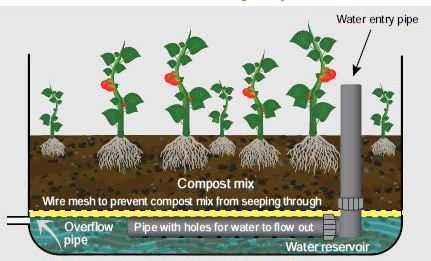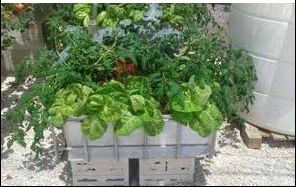9.3 INTEGRATING AQUAPONICS WITH OTHER GARDENS
Aquaponics can be used alone, but it becomes a stronger tool for the small-scale farmer when used in conjunction with other agriculture techniques. It has already been discussed how other plants and insects can be grown to supplement the fishes' diet, but aquaponics can also help the rest of the garden. Generally, the nutrient-rich water from the aquaponic units can be shared among other plant production areas.
9.3.1 Irrigation and fertilization
Aquaponic units are a source of nutrient-rich water for vegetable production. This water can also be used to fertilize ornamental plants, lawns or trees. Aquaponic water is an excellent organic fertilizer for all soil-based production activities. For vegetables growing in raised beds or patches, aquaponic water can be periodically taken from the unit and irrigated onto the growing space, giving the soil a boost of essential nutrients for the vegetables. If growing larger fruiting vegetables (i.e. tomatoes) using satellite pots in the garden or in any space with good access to sunlight, aquaponic water can also be used as a nitrate-rich fertilizer during the early stages of leaf and stem development. Aquaponic water is also good for seed starting.
9.3.2 Irrigating wicking beds
Wicking beds are another form of raised bed garden that are extremely water-efficient. The bed itself has a water reservoir at the bottom of the container filled with large. gravel. Above this gravel is a good mixture of moisture-retaining soil. These two zones are usually separated with shade cloth, geotextile or other fabric. The plants are planted within the soil. A refill pipe leads down through the top zone of soil down into the bottom zone of the water reservoir. The water is drawn upward from the reservoir into the root zone by capillary action (Figure 9.15). This removes the need for overhead watering and much less water is lost through evaporation. Roots growing in the moist soil have a continuous supply of water, oxygen and nutrients. Wicking beds can be watered with standard water, but using aquaponic water also supplies nutrients and avoids the need for fertilizers. A valve installed at the bottom of wicking bed containers helps to periodically flush the water preventing the buildup of salts and/or anaerobic zones.

FIGURE 9.15
Illustration of a wicking bed system
Wicking beds are an excellent method of growing vegetables in arid, water-scarce regions as only up to half of the water is needed compared with standard top-down irrigation methods. Wicking beds can be made out of water proof containers or dug into the ground and sealed with a polyethylene liner that stores the water, making them ideal methods to produce food in arid and semi- arid urban areas with little or no access to soil (Figure 9.16).
Another method is to place a wicking bed on top of a media bed within the aquaponic system proper. The fabric essentially creates a one-way passage, keeping soil out of the system but allowing water to percolate up into the root zone. This method can be used to grow tubers and root vegetables such as taro root, onions, beets and carrots. For further information on the wicking bed concept, see the sources listed in the section on Further Reading.

FIGURE 9.16
An example of a wicking bed using a plastic container